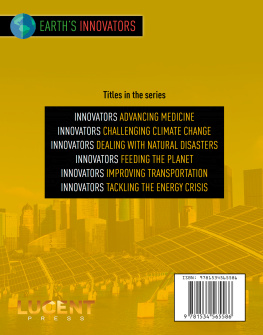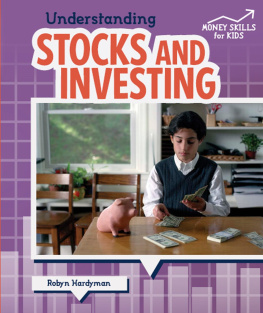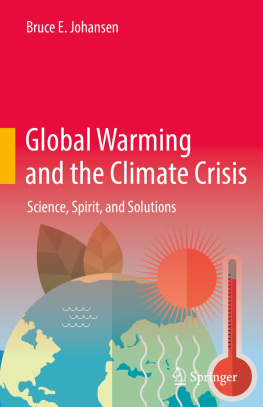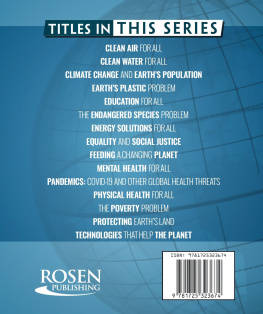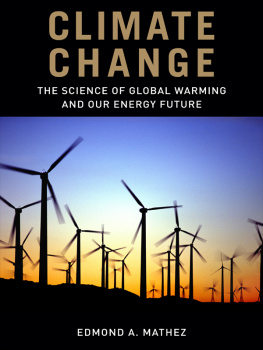
Published in 2020 by
Lucent Press, an Imprint of Greenhaven Publishing, LLC
353 3rd Avenue
Suite 255
New York, NY 10010
Copyright (c) 2020 Lucent Press, an Imprint of Greenhaven Publishing, LLC
All rights reserved. No part of this book may be reproduced in any form without permission in writing from the publisher, except by a reviewer.
Produced for Lucent by Calcium
Designers: Paul Myerscough and Simon Borrough
Picture researcher: Rachel Blount
Editors: Sarah Eason and Jennifer Sanderson
Picture credits: Cover: Shutterstock: Artistic Photo; Inside: 4per1000: pp. 403, .
Cataloging-in-Publication Data
Names: Hardyman, Robyn.
Title: Innovators challenging climate change / Robyn Hardyman.
Description: New York: Lucent Press, 2020. | Series: Earths innovators | Includes glossary and index.
Identifiers: ISBN 9781534565579 (pbk.) | ISBN 9781534565586 (library bound) | ISBN 9781534565593
(ebook)
Subjects: LCSH: Climatic changes--Juvenile literature. | Global warming--Juvenile literature. | Climatic
changes--Prevention--Technological innovations--Juvenile literature. | Climatic changes--Risk
management--Juvenile literature. | Global warming--Prevention--Technological innovations--Juvenile
literature.
Classification: LCC QC981.8.C5 H37 2020 | DDC 551.6--dc23
Printed in the United States of America
CPSIA compliance information: Batch #BS19KL:
For further information, contact Greenhaven Publishing, LLC, New York, New York, at 1-844-317-7404.
Please visit our website, www.greenhavenpublishing.com.
For a free color catalog of all our high-quality books, call toll free 1-844-317-7404 or fax 1-844-317-7405.
Contents
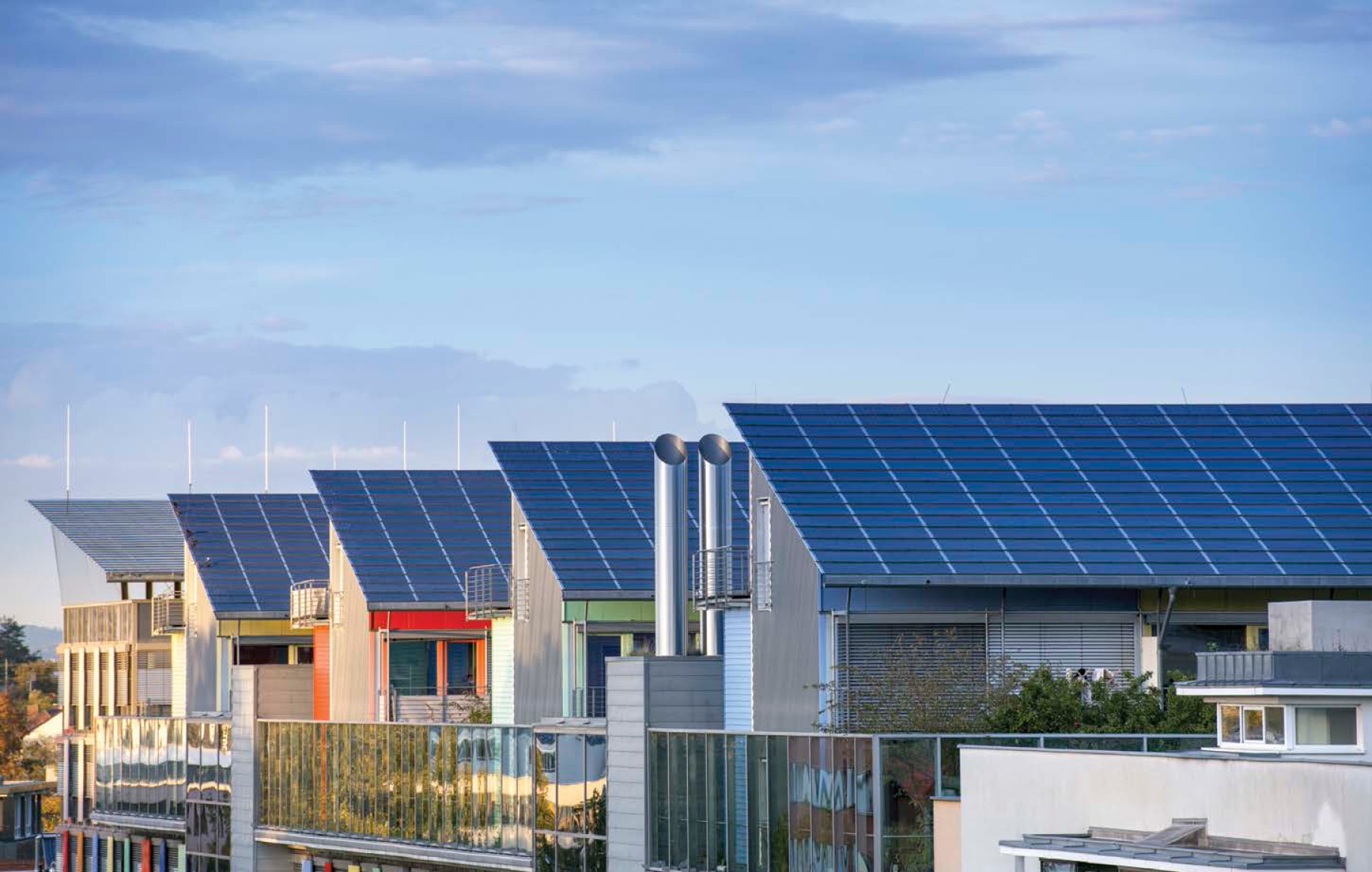
CHAPTER 1
A TRULY GLOBAL CHALLENGE
Climate is the regular pattern of weather in a location over a long period. It is the big picture of how much it rains and whether it is generally cold or warm. The climate is different around the world from place to place, but the global climate is the average climate around the whole world. In recent decades, the global climate has started to change. This global climate change is what scientists are worried about, because it is having a negative effect on our planet.
Getting Hotter
Earth is gradually warming up, and it is happening faster than at any time in the history of the world. The air temperature near Earths surface rose almost 1.5 degrees Fahrenheit (0.8 degrees C) in the last century. Earth has warmed twice as fast in the last 50 years as in the 50 years before that. Although 1.5 degrees may not seem like a lot, it is enough to cause many damaging changes.

In the Arctic, some of the ice never melts. These two photos show how the amount of ice that remains there through the summer has reduced dramatically since 1980. This is because of global warming.

Climate change is making some areas of the world much drier. Drought makes it impossible for farmers to grow crops.
Scientists have learned that this rise in temperature is because of the way we are living. Our homes, industry, transportation, and agriculture are all emitting gases called greenhouse gases. These are collecting above us in Earths atmosphere. They act like a blanket around Earth, trapping the heat from the sun so it cannot escape. This warms the overall air temperature around the world.
The worst greenhouse gas is carbon dioxide, or CO2. This is emitted when we burn fossil fuels such as coal, oil, and natural gas. We do this all the time in power stations to create electricity, which powers just about everything, and in our cars when we drive on gasoline or diesel.
Does It Matter?
Global warming certainly does matter because it is making the climate change. As the world warms, the ice at the North and South Poles is melting. This makes the sea level rise, which is dangerous for people living along coastlines. Millions of people could lose their homes if this continues. Other effects of a warmer world are drought, or long periods without rain, in some areas, and flooding, caused by heavier rainfall, in others. Extremes of weather are becoming much more common as the world is warming.
Climate change is the most serious problem facing the world today, and it is a truly global challenge. It affects both rich and poor countries, and people everywhere are working hard to find solutions.
Getting Prepared
While people are working hard to prevent the causes of climate change from becoming worse, there are some effects that are too late to stop. Governments and individuals are focused on preparing for these, such as extremes of weather and the effects of rising sea levels. This is known as building resilience.
Building Resilience
Climate resilience is the ability to anticipate, prepare for, and respond to hazardous events or disturbances related to the climate. We need to understand how climate change will create risks for us and prepare for those risks. Businesses, for example, are looking at ways to respond to extreme weather events such as storms and floods. Countries and states are bringing people together to work on solutions. In the United States, at least 15 states already have climate resilience plans, and more are developing them. Examples include how to look after communities along the coast that may be threatened by rising sea levels, or communities that are especially likely to experience floods after heavy rainfall.

California has advanced climate resilience plans. Its former governor, Arnold Schwarzenegger, worked hard to start this process.

Wildfires are a common sight in California, causing damage to peoples farmland, businesses, and property.
Preparation in California
In the United States, California is leading the way in working to combat climate change. The state is being hit by record droughts and rainfalls, resulting in wildfires, flooding, and mudslides. In 2006, Californias governor, Arnold Schwarzenegger, made a new law, the Global Warming Solutions Act, which requires the state to reduce its greenhouse gas emissions to the levels they were at in 1990 by 2020. That goal is on track, and the state is now aiming for a target of 80 percent below 1990 levels by 2050. Californias emissions are 40 percent lower than the U.S. average.
Meanwhile, California also has measures for protecting land and property from fire. One of these is building with materials that are less likely to catch fire, so not with wood, for example. Another is making sure there is space around a property, so that if one house is ablaze, the flames will not automatically spread to the next one. Out in open country, wide strips of vegetation can be cleared, so that a fire will have nothing to burn when it reaches them and it will stop moving forward.
Next page
